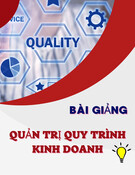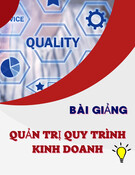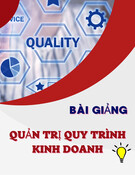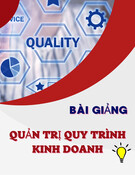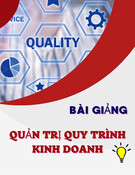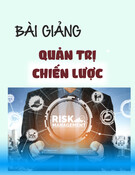LOGO
EM3300: Quản trị quy trình kinh doanh
Chương 1:
Tổng quan về quản trị quy trình kinh doanh
Dr. Tran Thi Huong
Department of Business Administration
School of Economics and Management (SEM)
Hanoi University of Science and Technology (HUST)
huong.tranthi@hust.edu.vn
1
Nội dung chính chương 1
Chương 1: Tổng quan về quản trị quy trình kinh doanh
1.1 Khái niệm về quy trình kinh doanh
1.2 Cấu phần của quy trình kinh doanh
1.3 Khái niệm và tầm quan trọng của quản trị quy trình kinh doanh
1.4 Nguồn gốc và sự phát triển của quản trị quy trình kinh doanh
1.5 Chu trình quản trị quy trình kinh doanh
1.6 Một số hệ thống liên quan đến quản trị quy trình kinh doanh
2
1.1 Khái niệm về quy trình kinh doanh
v Quy trình kinh doanh/ Business Process?
là tập hợp các hoạt động có chủ đích, có quan hệ lẫn nhau và tương tác để chuyển hoá
các đầu vào thành các đầu ra, nhằm mang lại giá trị gia tăng
Inputs
Outputs
Any organization can be characterized as a process or a network of processes
Process
• Chuyển hoá vật chất (từ nguyên vật liệu thôÞthành phẩm)
• Chuyển hoá mang tính vị trí (vận chuyển từ Hà Nội đến Huế)
• Chuyển hoá theo kiểu các giao dịch (gửi tiền vào tài khoản ngân hàng)
v Các loại hình chuyển hoá
3
• Chuyển hoá mang tính thông tin (thông tin kế toán Þbáo cáo tài chính)
1.1 Khái niệm về quy trình kinh doanh
v Quy trình kinh doanh/ Business Process?
là một mạng lưới các hoạt động chính và hoạt động phụ trợ/ tầng đệm
(buffers) với những ranh giới và thứ tự ưu tiên được xác định rõ ràng, để
khai thác tối đa nguồn lực nhằm biến đổi các đầu vào thành các đầu ra nhằm
thỏa mãn nhu cầu của khách hàng.
Resources
Process
Suppliers
Inputs
Customers
Outputs
4
1.1 Khái niệm về quy trình kinh doanh
Về bản chất, một quy trình kinh doanh là
ü một chuỗi các sự kiện (events), hoạt động (activities), và quyết định (decisions) ü … liên quan đến một số tác nhân (actors) và đối tượng (objects) ü … được khởi tạo bởi một nhu cầu nào đó (need) ü và kết quả là tạo ra một đầu ra (outcome) nào đó mà có giá trị đối với khách hàng
(customer)
v Order-to-Cash: quá trình xử lý đơn hàng của khách hàng đến lúc nhận được tiền
v Quote-to-Order: quá trình từ lúc khách hàng yêu cầu báo giá đến quyết định đặt hàng
v Procure-to-Pay: quá trình từ lúc tìm kiếm nhà cung cấp để mua hàng đến lúc trả tiền
v Issue/ Fault-to-Resolution: quá trình xử lý các vấn đề, feedbacks, phàn nàn, …
v Application-to-Approval: quá trình nộp đơn/ đề xuất đến lúc được phê duyệt
Một số ví dụ điển hình về quy trình có ở hầu hết các tổ chức:
5
“My washing machine doesn’t work…”
Positive outcomes (value-adding): • Fault repaired immediately with minor
intervention
Negative outcomes (value-reducing): • Fault not repaired in a timely manner • Fault repaired but customer pays
• Fault repaired, covered by warranty
more than expected
Insurance Company
Call Centre
Technician
Customer Customer
Customer
Parts Store
Service Dispatch Centre
fault-to-resolution process
E U L A V
Thảo luận
v Xem xét một tổ chức/ doanh nghiệp và một quy trình mà họ
thực hiện:
§ Quy trình đó là kiểu quy trình nào?
order-to-cash, procure-to-pay, fault-to-resolution…
§ Ai là khách hàng của quy trình
§ Giá trị mà quy trình đó mang đến cho khách hàng?
§ Tác nhân chính (Key actors) của quy trình?
§ Liệt kê tối thiểu 3 kết cục (outcomes) của quy trình
7
1.2 Cấu phần của quy trình kinh doanh
Một quy trình kinh doanh bao gồm một số các sự kiện và hoạt động/ nhiệm vụ
Một quy trình điển hình sẽ có các nút ra quyết định
Một quy trình cũng liên quan đến
§ Các tác nhân, bao gồm con người, tổ chức, hệ thống thông tin thực hiện các hành động thay mặt cho con người và/ hoặc tổ chức. Các tác nhân có thể là những thành viên bên trong hoặc bên ngoài tổ chức/ doanh nghiệp.
§ Những đối tượng vật chất, như phương tiện, trang thiết bị, nguyên vật liệu, sản
phẩm, tài liệu, thư từ, ấn phẩm, …
§ Những đối tượng phi vật chất truyền tải/ chứa đựng thông tin như các tài liệu/
bản ghi điện tử
Sự thực thi một quy trình sẽ dẫn đến một hoặc nhiều đầu ra (tích cực/ tiêu cực)
Câu hỏi đặt ra khi xem xét một quy trình
§ Who are the actors in this process? § Which actors can be considered as customers in this process? § What value does the process deliver to its customers? § What are the possible outcomes of this process?
1.2 Cấu phần của quy trình kinh doanh
Ingredients of a Business Process Source: Marlon Dumas et al. (2018)
12
1.2 Cấu phần của quy trình kinh doanh
Các đầu vào và đầu ra Hệ thống/ Cấu trúc thông tin
Inputs and Outputs Information structure
Các nguồn lực
Cấu phần của quy trình
Các luồng vật chất/ thông tin Resources
Flow units
@ Mohamed Zairi
Mạng lưới các hoạt động và tầng đệm
The network of activities and buffers
13
Example 1.1 (trang 3)
1. BuildIT is a construction company specialized in public works, such as roads, bridges, pipelines, tunnels and railroads. Within BuildIT, it often happens that engineers working at a construction site (called site engineers) need a piece of equipment, such as a truck, an excavator, a bulldozer, a water pump, etc. BuildIT owns very little equipment and instead it rents most of its equipment from specialized suppliers.
2. The existing business process for renting equipment goes as follows. When site engineers need to rent a piece of equipment, they fill in a form called “Equipment Rental Request” and send this request by email to one of the clerks at the company’s depot. The clerk at the depot receives the request and, after consulting the catalogs of the equipment suppliers, selects the most cost- effective equipment that complies with the request. Next, the clerk checks the availability of the selected equipment with the supplier via phone or email. Sometimes the selected option is not available. In these cases, the clerk has to select an alternative piece of equipment and check its availability with the corresponding supplier.
3. After finding a suitable and available piece of equipment, the clerk adds the details of the selected equipment to the rental request. Each rental request has to be approved by a works engineer, who also works at the depot. In some cases, the works engineer rejects the equipment rental request. Some rejections lead to the cancelation of the request, i.e., no equipment is rented at all. Other rejections are resolved by replacing the selected equipment with another equipment—such as a cheaper piece of equipment or a more appropriate piece of equipment for the job. In this latter case, the clerk needs to lodge another availability request.
14
Example 1.1 (trang 3) tiếp
5.
4. When a works engineer approves a rental request, the clerk sends a confirmation to the supplier. This confirmation includes a Purchase Order (PO) for renting the equipment. The PO is produced by BuildIT’s financial information system using information entered by the clerk. The clerk also records the equipment rental in a spreadsheet that is used to monitor all ongoing equipment rentals. In the meantime, the site engineer may decide that the equipment is no longer needed. In this case, the engineer asks the clerk to cancel the request for renting the equipment. In due time, the supplier delivers the rented equipment to the construction site. The site engineer then inspects the equipment. If everything is in order, the site engineer accepts the engagement and the equipment is put into use. In some cases, the equipment is sent back because it does not comply with the requirements of the site engineer. In this case, the site engineer has to start the rental process all over again.
6. When the rental period expires, the supplier comes to pick up the equipment. Sometimes, the site engineer asks for an extension of the rental period by contacting the supplier via email or phone 1 to 2 days before pick-up. The supplier may accept or reject this request. A few days after the equipment is picked up, the equipment’s supplier sends an invoice to the clerk by email. At this point, the clerk asks the site engineer to confirm that the equipment was indeed rented for the period indicated in the invoice. The clerk also checks if the rental prices indicated in the invoice are in accordance with those in the PO. After these checks, the clerk forwards the invoice to the financial department. The financial department eventually pays the invoice.
15
Exercise 1.1 (trang 5)
1.
In order to apply for admission, students first fill in an online form. Online applications are recorded in an information system to which all staff members involved in the admissions process have access. After a student has submitted the online form, a PDF document is generated and the student is requested to download it, sign it, and send it by post together with the required documents, which include:
• • • •
certified copies of previous degree and academic transcripts, results of English language test, curriculum vitae, two reference letters.
2. When these documents are received by the admissions office, an officer checks the completeness of the documents. If any document is missing, an email is sent to the student. The student has to send the missing documents by post. Assuming the application is complete, the admissions office sends the certified copies of the degrees to an academic recognition agency, which checks the degrees and gives an assessment of their validity and equivalence in terms of local education standards. This agency requires that all documents be sent to it by post, and that all documents be certified copies of the originals. The agency sends back its assessment to the university by post. Assuming the degree verification is successful, the English language test results are then checked online by an officer at the admissions office. If the validity of the English language test results cannot be verified, the application is rejected (such notifications of rejection are sent by email).
Exercise 1.1 (trang 5) tiếp
3. Once all documents of a given student have been validated, the admissions office forwards these
documents by internal mail to the corresponding academic committee responsible for deciding whether to offer admission or not. The committee makes its decision based on the academic degrees and transcripts, the CV, and the reference letters. The committee meets once every three months to examine all applications that are ready for academic assessment at the time of the meeting.
4. At the end of the committee meeting, the chair of the committee notifies the admissions office of the selection outcomes. This notification includes a list of admitted and rejected candidates. A few days later, the admissions office notifies the outcome to each candidate via email. Additionally, successful candidates are sent a confirmation letter by post.
§ Who are the actors in this process? § Which actors can be considered as customers in this process? § What value does the process deliver to its customers? § What (activities/ tasks) does each actor have to carry out? § What are the possible outcomes of this process?
1.3 Khái niệm và tầm quan trọng của BPM
Quản trị quy trình kinh doanh (BPM)
v giới thiệu một quan điểm định hướng theo quy trình/ quá trình của việc quản trị luồng nguyên vật liệu, thông tin, và dịch vụ xuyên suốt tổ chức/ doanh nghiệp
v bao gồm các khái niệm, phương pháp, và kỹ thuật để hỗ trợ việc thiết kế, quản trị, cấu hình, thể chế hoá, và phân tích quy trình kinh doanh
v không chỉ tập trung ở phạm vi một quy trình nhất định, BPM hướng tới hiện thực hoá mục tiêu của toàn bộ tổ chức thông qua việc thấu hiểu, cải tiến và tối ưu các quy trình kinh doanh
BPM is not about improving the way individual activities are performed, but rather,
it is about managing entire chains of events, activities and decisions that
ultimately add value to the organization.
18
1.3 Khái niệm và tầm quan trọng của BPM
v Six core elements of BPM
19
1.3 Tầm quan trọng của BPM
Quản trị quy trình kinh doanh hiệu quả sẽ giúp tổ chức
v Giảm chi phí vận hành/ Reduce operation cost
v Duy trì sự ổn định của hoạt động kinh doanh/ Maintain stability of business
v Có được hệ thống tốt/ quy trình tốt, kéo theo những sản phẩm và dịch vụ tốt
Good system/ processes result in good products and services
v Đảm bảo sự thông suốt/ minh bạch của thông tin/ Information transparency
v Giảm thiểu sai lỗi/ Reduce defects/ failures
v Tăng khả năng truy xuất/ Track and trace
Processes Everywhere
20
1.3 Tầm quan trọng của BPM
Nếu phải/ được lựa chọn giữa hai dịch vụ, bạn sẽ chọn dịch vụ nào? Dựa trên tiêu chí nào? one that is:
Faster Cheaper Better
v F… v C… v B…
BPM hỗ trợ tổ chức tạo nên những
dịch vụ đáp ứng các tiêu chí trên nhờ
tư duy quản trị định hướng quy trình
và sự hỗ trợ của công nghệ thông tin
21
1.3 Tầm quan trọng của BPM
Trong bối cảnh chuyển đổi số …
BPM cung cấp nền tảng làm cầu nối giữa IT và kinh doanh, bởi vì nhiều (hầu
hết) các dự án IT trong các doanh nghiệp nếu nhằm mục đích tối cao là cải
tiến một quy trình kinh doanh nào đó.
Yields
Information Technology
Business Value
Enables
Yields
Nói theo một cách khác
Process Change
22
Why BPM?
“The first rule of any technology used in a business is that automation applied to an efficient operation will magnify the efficiency.
The second is that automation applied to an inefficient operation will magnify the inefficiency.”
Bill Gates 23
Why BPM? The management Perspective
24
Why BPM? The management Perspective
25
1.4 Nguồn gốc và sự phát triển của BPM
§ The Functional Organization
§ The Birth of Process Thinking
§ The Rise and Fall of BPR (Business Process Re-engineering)
@Paul Harmon
26
How process moved out of focus through ages
toàn bộ quy trình cho tất cả sản phẩm
toàn bộ quy trình cho một sản phẩm đơn lẻ
một phần của một quy trình cho một sản phẩm đơn lẻ
mối quan tâm của công nhân
năng lực của công nhân
hoàn toàn không chuyên môn hoá
chuyên môn hoá hoàn toàn
chuyên môn hoá trung cấp
người đa năng
thời tiền sử
thời cổ đại
thời trung đại
thời công nghiệp
Adam Smith: Các quy trình và sự phân công lao động
Quy trình sản xuất pin
Source: Smith 1776 Picture: http://www.library.hbs.edu/hc/ collections/kress/kress_img/ada m_smith2.htm
Frederick W. Taylor: Quản lý theo khoa học
v Ra đời cùng với sự mở rộng quy mô sản xuất của các nhà máy
v Nghiên cứu tỉ mỉ các hoạt động lao động; Hướng dẫn công việc cho công nhân
v Hình thành nên tầng lớp các nhà quản lý (class of managers) giám sát năng suất
của các nhóm công nhân à sự cần thiết chỉ ra sự khác biệt về trách nhiệm của
các nhà quản lý à Khác biệt theo các nhóm công đoạn sản xuất họ phụ trách;
hoặc khác biệt theo cấu trúc thứ bậc
à Sự hình thành việc tổ chức theo chức năng
Source: Wikimedia Commons
(Functional Organization)
Functional Organization
v Tổ chức theo chức năng chiếm ưu thế cho đến cuối những năm 1980, khi mà
IBM, Ford, và Bell Atlantic (bây giờ là Verizon) nhận ra rằng việc tập trung vào tổ
chức theo chức năng đã đang tạo ra những điểm thiếu hiệu quả trong hoạt động
tác nghiệp, làm giảm lợi thế cạnh tranh
v Những dự án IT, tái cấu trúc đắt đỏ được triển khai
à Ý tưởng về BPR và sự ra đời của tư duy
Source: Wikimedia Commons
quản lý theo quá trình/ quy trình
The Birth of Process Thinking
Business Process Reengineering (BPR) Tái cấu trúc quy trình kinh doanh
“the fundamental rethinking and radical redesign of business processes to achieve dramatic improvements in critical, contemporary measures of performance, such as cost, quality, service, and speed.”
Ví dụ về quy trình mua hàng tại Ford: Trước cải tiến
at Mazda only five people worked in this department
Ví dụ về quy trình mua hàng tại Ford: Sau cải tiến
a 76% reduction
Thảo luận
Xem xét quy trình mua hàng (purchasing process) tại Ford,
trả lời các câu hỏi sau:
1. Who are the actors in this process?
2. Which actors can be considered as customers in this process?
3. What value does the process deliver to its customers?
4. What are the possible outcomes of this process?
The Rise and Fall of BPR: Thăng trầm của BPR
v Từ 1980s đến nửa đầu 1990s: BPR phát triển mạnh mẽ với sự ra đời của hàng loạt các sách, báo cáo, và các nhóm dự án BPR trong hầu khắp các công ty lớn trên thế giới.
v Những năm cuối thập kỷ 1990: rất nhiều công ty đã dừng triển khai các dự án BPR và
ngừng hỗ trợ các nỗ lực liên quan đến BPR.
Một số lý do có thể kể đến:
1. Lạm dụng khái niệm BPR: Nhiều dự án gắn nhãn BPR nhưng thực chất không tập trung vào các quy trình kinh doanh; Nhiều tập đoàn đã cắt giảm lao động trong quá trình thực hiện BPR gây ra nhiều phẫn nộ
2. Chủ nghĩa cực đoan: “Nếu không tự động hoá, thì xoá sổ”; Nhiều trường hợp đòi
hỏi sự thay đổi từ từ
3. Thiếu sự hỗ trợ: Nhiều công cụ hay công nghệ cần thiết chưa sẵn có hoặc không đầy đủ. Nhiều quy trình logic phải được mã hóa cứng trong các ứng dụng CNTT thời đó. Mọi người trở nên thất vọng khi họ lưu ý rằng nỗ lực của họ trong việc thiết kế lại quy trình đã bị cản trở bởi một cơ sở hạ tầng cứng nhắc
Reshaping Process Thinking: Thời phục hưng của BPR
Workflow Management Systems (WfMSs)
a single shared and centralized database enables the optimization of information usage and information exchanges, which is a key enabler of process improvement
Business Process Management Systems (BPMSs)
Process Orientation is productive ERP Systems penetrate the market
Job Functions of Process Owner
Nội dung chính chương 1
Chương 1: Tổng quan về quản trị quy trình kinh doanh
1.1 Khái niệm về quy trình kinh doanh
1.2 Cấu phần của quy trình kinh doanh
1.3 Khái niệm và tầm quan trọng của quản trị quy trình kinh doanh
1.4 Nguồn gốc và sự phát triển của quản trị quy trình kinh doanh
1.5 Chu trình quản trị quy trình kinh doanh
38
1.5 Chu trình quản trị quy trình kinh doanh
BPM Life Cycle
Process identification
Process architecture Process architecture
Process discovery
As-is process As-is process model model
Conformance and Conformance and performance insights performance insights
Process analysis
Process monitoring and controlling
Executable Executable process process model model
Insights on Insights on weaknesses and weaknesses and their impact their impact
Process implementation
Process redesign
To-be process To-be process model model
EM3300 Quản trị quy trình kinh doanh 39
1.5 Chu trình quản trị quy trình kinh doanh
Chương 1
BPM Life Cycle
Xác định Process identification quy trình
Process architecture Process architecture
As-is process As-is process model model
Conformance and Conformance and performance insights performance insights
Khám phá Process discovery quy trình
Chương 2
Chương 3
Phân tích Process analysis quy trình
Process Kiểm soát monitoring and quy trình controlling
Chương 4
Executable Executable process process model model
Insights on Insights on weaknesses and weaknesses and their impact their impact
T.kế lại Process redesign quy trình
Triển khai Process implementation quy trình
To-be process To-be process model model
EM3300 Quản trị quy trình kinh doanh 40
Process identification: Xác định quy trình cần quản trị
1. Define process architecture
§ Enumerate main processes
Xác định số lượng quy trình chính
understanding of the processes and their interrelationship
§ Determine process scope
Xác định phạm vi của quy trình
2. Prioritization step (aka Process selection)
Prioritized Process Portfolio for the BPM activities
Prioritize and select processes based on: Xác định thứ tự ưu tiên và lựa chọn quy trình dựa trên: § Importance/ Tầm quan trọng của quy trình § Health/ Sức khoẻ/ Thực trạng của quy trình § Feasibility/ Mức độ khả thi
Ví dụ về process architecture của Wholesaler
Strategic Management
Suppliers Management
Logistics Management
Warehouse Management
Demand Management
Management processes
Sales
Distribution
Direct procurement
Marketing
Service
Core processes
IT
HR
Finance
Indirect procurement
Support processes
42
Process Selection: Xác định quy trình
3 tiêu chí để xác định thứ tự ưu tiên và lựa chọn quy trình
1.
Importance/ Tầm quan trọng của quy trình Which processes have greatest impact on the organization‘s strategic objectives? Những quy trình nào có tác động lớn nhất lên mục tiêu chiến lược của tổ chức?
2. Health (or Dysfunction)/ Sức khoẻ/ Thực trạng của quy trình
Which processes are in deepest trouble? Những quy trình nào đang gặp phải vấn đề nghiêm trọng nhất?
3. Feasibility/ Mức độ khả thi
Which processes are most susceptible to successful process management? Những quy trình nào nhạy cảm nhất/ dễ mang lại thành công cho hoạt động quản trị quy trình?
Prioritized process portfolio/ Danh sách các quy trình đã được xác định thứ tự ưu tiên
43
Selection Criteria/ Các tiêu chí lựa chọn
v Strategic Importance/ Tầm quan trọng chiến lược
§ Những quy trình nào có tác động lớn nhất lên mục tiêu chiến lược của tổ chức
§ Xem xét về khả năng sinh lời, tính duy nhất, hay đóng góp vào lợi thế cạnh tranh của
quy trình
§ Lựa chọn những quy trình cần thống nhất với chiến lược phát triển của tổ chức
v Health/ Sức khoẻ/ Thực trạng của quy trình
§ Xác định những quy trình đang có vấn đề/ tồn tại nghiêm trọng nhất (dựa vào các chỉ
tiêu đo lường kết quả và hiệu quả (performance measures) sẽ học ở chương 3)
§ Những quy trình này có thể sẽ nhận được nhiều lợi ích nhất khi triển khai dự án BPM
v Feasibility/ Mức độ khả thi
§ Xác định quy trình này có độ nhạy như thế nào với những nỗ lực BPM
§ Văn hoá công ty và vấn đề chính trị có thể chính là những chướng ngại vật
§ BPM nên tập trung vào những quy trình mà có cơ sở khoa học rằng sẽ mang lại lợi ích
Process Performance Measures
Performance Objectives
v Formulate performance objectives of the process at a
high level, in the form of a desirable state that the
process should ideally reach, e.g., customers should
be served in less than 30 minutes.
v For each performance objective, identify the
Performance Measures v Time v Cost v Quality v Flexibility
relevant performance dimension(s) and aggregation
function(s), and from there, define one or more
Ví dụ 2.3: Restaurant
performance measures for the objective in question,
e.g., the percentage of customers served in less than
30 minutes. Let us call this measure ST(30).
v Define a more refined objective based on this
performance measure, such as
ST(30) >99%.
Exercise 2.8: Các tiêu chí lựa chọn
v Xem xét lại ví dụ 1.1 và bài tập 1.1 về quy trình procure-to-pay của công ty BuildIT
(trang 3) và quy trình nhập học của một trường đại học (trang 5)
1. Hãy cùng thảo luận về tầm quan trọng chiến lược, sức khoẻ, mức độ khả thi của
việc cải tiến những quy trình này?
2. Đối với các tiêu chí đã được thảo luận ở trên, liệu có phải lúc nào việc đánh giá
tầm quan trọng, sức khoẻ, và mức độ khả thi cũng sẽ đưa ra cùng một kết quả về
quy trình cần quản trị?
3. Liệu tất cả các quy trình cần quản trị lúc nào cũng cần ở trong tình trạng không
tốt, luôn có tầm quan trọng chiến lược, và khả thi để quản trị/ cải tiến?
Ví dụ và bài tập cho bước 1: Process Identification
Ví dụ về danh mục các quy trình với thứ tự ưu tiên
Tại một tổ chức tài chính
Short-term action
High
Feasibility
Rating
Low
Loan controlling
Contract preparation
Medium
High
Loan decision
Loan market evaluation
e c n a t r o p m
I
Handling of payments
Loan planning
Loan application
Low
Poor
Good
Health
Strategic fit?
Possible
EM3300 Quản trị quy trình kinh doanh 47
Ví dụ và bài tập cho bước1: Process Identification
Example 2.3: Restaurant
v In this scenario, most relevant
performance dimension is serving time.
v One objective is to completely
avoid waiting times above 30 min.
v A restaurant has recently lost many customers due to poor customer service. The management team has decided to address this issue first of all by focusing on the delivery of meals.
v Percentage of customers served in less than 30 min should be close to 100%.
v The team gathered data by asking customers about how quickly they liked to receive their meals and what they considered as an acceptable wait.
v Thus, the percentage of customers served in less than 30 minutes is relevant performance measure.
v Threshold mentioned in scenario is
15 min.
v The data suggested that half of the customers would prefer their meals to be served in 15 min or less. All customers agreed that a waiting time of 30 min or more is unacceptable
v Choice between two performance measures: average meal delivery time or percentage of customers served in 15 min.
Ví dụ và bài tập cho bước 1: Process Identification
Exercise 2.9: Travel Agency
Consider the following summary of issues reported in a travel agency. v A travel agency has recently lost several medium-sized and large corporate customers due to complaints about poor customer service. The management team of the travel agency decided to appoint a team of analysts to address this problem. The team gathered data by conducting interviews and surveys with current and past corporate customers and also by gathering customer feedback data that the travel agency has recorded over time.
v About 2% of customers complained about errors that had been made in their bookings. In one occasion, a customer had requested a change to a flight booking. The travel agent wrote an email to the customer suggesting that the change had been made and attached a modified travel itinerary. However, it later turned out that the modified booking had not been confirmed in the flight reservation system. As a result, the customer was not allowed to board the flight and this led to a series of severe inconveniences for the customer.
Ví dụ và bài tập cho bước 1: Process Identification
Exercise 2.9: Travel Agency
v Similar problems had occurred when booking a flight initially: the customer had asked for certain dates, but the flight tickets had been issued for different dates. Additionally, customers complained of the long times it took to get responses to their requests for quotes and itineraries. In most cases, employees of the travel agency replied to requests for quotes within 2-4 working hours, but in the case of some complicated itinerary requests (about 10% of the requests), it took them up to 2 days.
v Finally, about 5% of customers also complained that the travel agents did not find the best flight connections and prices for them. These customers essentially stated that they had found better itineraries and prices on the Web by searching by themselves.
1. Which business processes should the travel agency select for improvement? 2. For each of
the business processes you identified above,
indicate which
performance measure the travel agency should improve.
Bước 2: Process discovery/ Khám phá quy trình
The BPM lifecycle
Process identification
Process architecture Process architecture
Process discovery
As-is process As-is process model model
Conformance and Conformance and performance insights performance insights
Process analysis
Process monitoring and controlling
Executable Executable process process model model
Insights on Insights on weaknesses and weaknesses and their impact their impact
Process implementation
Process redesign
To-be process To-be process model model
EM3300 Quản trị quy trình kinh doanh
51
Bước 2: Process discovery/ Khám phá quy trình
Business process model/ Mô hình hoá quy trình
Invoice handling example
Invoice
ERP
Report
Invoice
Finance Department
Post Invoice
no mismatches
Enter Invoice Details
Check Invoice Mismatches
Invoice received
Invoice posted
Invoice
Invoice DB
Senior Finance Officer
mismatch exists
Block Invoice
Invoice blocked
EM3300 Quản trị quy trình kinh doanh
52
"Don't forget simplicity. This is what will help humans to make sense of what you are trying to say."
Bước 2: Process discovery/ Khám phá quy trình
Business process model
EM3300 Quản trị quy trình kinh doanh 53
Crowdsourcing Processes (Tranquillini và cộng sự (2015))
Bước 3: Process analysis/ Phân tích quy trình
The BPM lifecycle
Process identification
Process architecture Process architecture
Process discovery
As-is process As-is process model model
Conformance and Conformance and performance insights performance insights
Process analysis
Process monitoring and controlling
Executable Executable process process model model
Insights on Insights on weaknesses and weaknesses and their impact their impact
Process implementation
Process redesign
To-be process To-be process model model
54
Bước 3: Process analysis/ Phân tích quy trình
Qualitative process analysis/ Phân tích định tính
Ví dụ về phân tích nhân-quả/ Sơ đồ xương cá
Causal Factors
Issue
Measurement
Material
Machine
Clerk selected equipment with incorrect specs
The system does not keep the site engineer informed
Inaccurate equipment description in provider's catalogue
Equipment rejected at delivery
Clerk is entirely responsible for equipment selection
Incomplete or inaccurate requirements from site engineer
Site engineer does not validate the choice of equipment
Clerk misunderstood site engineer's requirement
Milieu
Man
Method
55
Bước 3: Process analysis/ Phân tích quy trình
Quantitative process analysis/ Phân tích định lượng
Ví dụ về mô phỏng quy trình kinh doanh
56
Bước 4: Process redesign/ Thiết kế lại quy trình
The BPM lifecycle
Process identification
Process architecture Process architecture
Process discovery
As-is process As-is process model model
Conformance and Conformance and performance insights performance insights
Process analysis
Process monitoring and controlling
Executable Executable process process model model
Insights on Insights on weaknesses and weaknesses and their impact their impact
Process implementation
Process redesign
To-be process To-be process model model
57
Bước 4: Process redesign/ Thiết kế lại quy trình
Process redesign/ Thiết kế lại quy trình
Cost
Time
Flexibility
Quality
58
TO-BE process model AS-IS process model
Bước 5: Process implementation/ Triển khai (cải tiến) quy trình
The BPM lifecycle
Process identification
Process architecture Process architecture
Process discovery
As-is process As-is process model model
Conformance and Conformance and performance insights performance insights
Process analysis
Process monitoring and controlling
Executable Executable process process model model
Insights on Insights on weaknesses and weaknesses and their impact their impact
Process implementation
Process redesign
To-be process To-be process model model
59
Bước 5: Process implementation/ Triển khai (cải tiến) quy trình
Process implementation/ Triển khai (cải tiến) quy trình
Process automation
Process change management
Job redesign
Executable process design
Training
IT development & configuration
Performance
Testing
management plan
...
….
Bước 6: Process monitoring and controlling/ Kiểm soát quy trình
The BPM lifecycle
Process identification
Process architecture Process architecture
Process discovery
As-is process As-is process model model
Conformance and Conformance and performance insights performance insights
Process analysis
Process monitoring and controlling
Executable Executable process process model model
Insights on Insights on weaknesses and weaknesses and their impact their impact
Process implementation
Process redesign
To-be process To-be process model model
61
Bước 6: Process monitoring and controlling/ Kiểm soát quy trình
Process monitoring and controlling/ Kiểm soát quy trình
Dashboards, alerts & reports
DB logs
Event stream
Model-based analytics
EM3300 Quản trị quy trình kinh doanh
62
Vai trò của các thành viên trong chu trình BPM
Process identification
BPM group
Process architecture Process architecture
Process discovery
As-is process As-is process model model
Conformance and Conformance and performance insights performance insights
Analyst
System admin/operati ons team
Process owner
Process analysis
Process monitoring and controlling
Process participants
Executable Executable process process model model
Insights on Insights on weaknesses and weaknesses and their impact their impact
Developer
Process implementation
Process redesign
To-be process To-be process model model
63
1.6 Một số hệ thống liên quan đến BPM
v Total Quality Management/ Hệ thống quản lý chất lượng toàn diện
v Operations Management/ Quản trị tác nghiệp
v Lean/ Hệ thống sản xuất tinh gọn
v Six Sigma
64
1.6.1 Total Quality Management (TQM): QLCL toàn diện
§ Tập trung vào cải tiến liên tục và duy trì, nâng cao chất lượng sản phẩm và dịch vụ.
§ TQM tập trung nỗ lực vào sản
phẩm và dịch vụ, BPM tập trung vào cải tiến các quy trình
§ TQM chủ yếu áp dụng trong lĩnh vực sản xuất, BPM áp dung nhiều hơn trong lĩnh vực dịch vụ
65
1.6.2 Operations Management: Quản trị vận hành
§ Quản trị luồng vật chất và các chức năng kỹ thuật trong tổ chức, đặc biệt là
những thứ liên quan đến sản xuất và tác nghiệp
§ Sử dụng lý thuyết xác suất, lý thuyết hàng đợi, phân tích quyết định, mô hình
toán, và mô phỏng để tối ưu hoá hiệu quả của hoạt động tác nghiệp
§ OM thường quan tâm nhiều hơn tới các quy trình hiện đang tồn tại, BPM quan
tâm nhiều hơn đến thay đổi/ cải tiến quy trình hiện tại để cải tiến nó.
66
1.6.3 Lean/ Hệ thống sản xuất tinh gọn
§ Phát triển từ lĩnh vực sản xuất, cụ thể là hệ thống sản xuất Toyota (TPS)
§ Tập trung vào giảm thiểu lãng phí, những hoạt động mà không mang lại giá trị
gia tăng cho khách hàng.
EM3300 Quản trị quy trình kinh doanh 67
§ BPM đặt trọng tâm nhiều hơn vào việc sử dung IT như là công cụ hữu hiệu để cải tiến các quy trình kinh doanh, khiến chúng trở nên đồng bộ hơn có thể và lặp lại được.
1.6.4 Six Sigma
§ Phát triển từ lĩnh vực sản xuất, cụ thể là hệ thống sản xuất của Motorola.
§ Tập trung vào tối thiểu hoá các lỗi có thể xảy ra (errors).
§ Coi trọng việc đo lường đầu ra của các quy trình, nhất là vấn đề về chất lượng
EM3300 Quản trị quy trình kinh doanh 68
§ Xu hướng gần đây là kết hợp giữa Lean và 6 Sigma (hệ thống LSS- Lean Six Sigma)
Homework
Exercise 1.6 to 1.7
Sách: Dumas, Marlon, et al. (2018) Fundamentals of business process management. Heidelberg: Springer.
EM3300 Quản trị quy trình kinh doanh 85
Upload bài tập lên MS Teams theo nhóm trước giờ học tiếp theo 24h
Câu hỏi cho bài tập 1.6 và 1.7
1. Xác định xem quy trình thuộc loại nào: order-to-cash, procure-to-pay, application-to-approval, or issue-to-resolution?
2. Những tác nhân/ actors/ những người tham gia vào quy trình?
3. Ai là khách hàng của quy trình?
4. Đâu là những tác vụ/ task/ actions cần phải thực hiện trong quy trình?
5. Giá trị mà quy trình này sẽ mang lại cho khách hàng
6. Những kết cục có thể có của quy trình?
7. Các chỉ tiêu đo lường kết quả của quy trình từ góc nhìn của khách hàng/ của nhà quản trị?
8. Những vấn đề có thể có/ cần phải giải quyết của quy trình này là gì? Những thông tin gì cần phải thu thập để phân tích kỹ hơn về vấn đề này?
9. Đề xuất ý tưởng/ giải pháp để thay đổi quy trình nhằm giải quyết vấn đề đã xác định ở trên?

